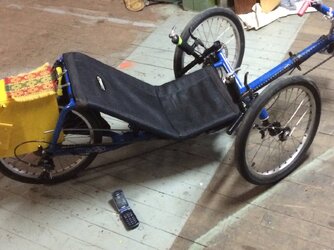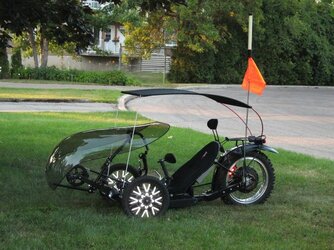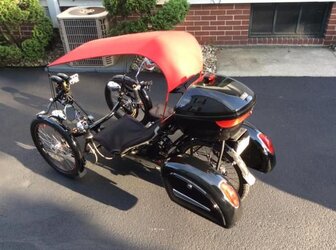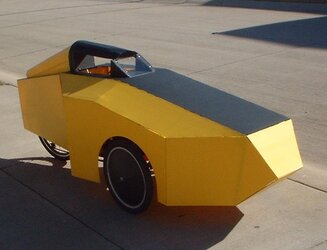Hillbilly Castro
Well-known member
Anyone get into this mode of bike life?
Right now I have a Catrike road..

The laid back position is incredibly comfortable, and the rider is able to draw an immense amount of power from against the seat. Hills are not the easiest until one gets their 'recumbent legs' and highway visibility to drivers is poor - that's a good reason to stick to backroads, which a smart tourer should do anyway.
Adding a gas motor to one of these is probably the ideal setup. It's the best of a car - a sit-down machine that demands little of you physically to traverse long distances - without the worst: DMV, insurance, tickets, shitty fuel economy, or the alienating removal from the wind and elements that a car gives.
With my Golden Eagle Bike engine, I pay about 3 cents a mile, including the cost of oil and maintenance. That's crossing the US for less than $100, going between 20 and 35mph the whole way. Some setups get pretty crazy:


These things do get pricey, however, with some intense Craigslisting, you can get the deals. Search the entire country (which is tedious) and physically go to where the best deal is. My Catrike road I got for abut $40 in Boston, though new they sell for $2800, and used they sell for half that. How? I offered to barter my skills as a woodworker - trading a reclaimed barnwood tabletop and nightstand for the trike. Another deal I found which I intend to purchase is a KMX frame kit trike for $500. These frame kits are sold on Amazon, meaning Zim's Amazi(o)n' scam can be done to get a free one. Build it yourself, and put a motor on.
I would estimate that anyone intending to buy a car to dwell out of would be able to get one of these systems running for a comparable price. And, if the gas price shoots up because of war or OPEC or peak oil or if the real-deal Mad Max days set in, you're still getting ten times better MPG than anyone else on the road, which is not true in a car.
At the next level are velomobiles:

These machines are constructed to maximally limit exposure to the elements and to reduce wind drag. The efficiency of a velomobile is so radically improved that one may see improvements of 20 to 40% in the efficiency of the vehicle. This velomobile here was DIYed with coroplast - corrugated plastic which sells from the manufacturer, Sabic, for about $20 per 4x8 sheet.
The only problem with these one may find is that the law finds them curious. They are viewed with curiosity by many city police. They are legal, however, if you have a gas engine within, the police may try to tell you your machine is illegal - even if your engine is smaller than the legal 49cc displacement. This may mean it is smart to stick to the freer areas of the US - rural areas in the west may be ideal.
The other major drawback is that on roads with a poor shoulder and no room for cars to pass, you may hold up traffic, pissing off drivers and police. Again, stick to backroads and wide open areas.
For all these drawbacks, you may find yourself getting 200+mpg with a 4 stroke, and will be able to operate comfortably in rain and perhaps even snow - if you have winter tires and some means of heating or insulating yourself.
Last, if you leave the US for points south, it may behoove you to have a larger engine displacement, with a sticker stating that it is 49cc, and generally operating at speeds under 35mph. When issues with traffic should arise, you can rest easy knowing that if you have to push it to 45 or 50, you can do that, and pass hazardous motorists in a sticky situation.
So there's my writeup on motorized recumbents. I'm hoping to secure funding to start cranking these out and selling them to solid travelers at cost, as I am convinced they are a superior mode of transit for a full-time traveler. I'm aiming to test this thesis once I get out west, and begin traveling on my motorized trike rig.
Right now I have a Catrike road..

The laid back position is incredibly comfortable, and the rider is able to draw an immense amount of power from against the seat. Hills are not the easiest until one gets their 'recumbent legs' and highway visibility to drivers is poor - that's a good reason to stick to backroads, which a smart tourer should do anyway.
Adding a gas motor to one of these is probably the ideal setup. It's the best of a car - a sit-down machine that demands little of you physically to traverse long distances - without the worst: DMV, insurance, tickets, shitty fuel economy, or the alienating removal from the wind and elements that a car gives.
With my Golden Eagle Bike engine, I pay about 3 cents a mile, including the cost of oil and maintenance. That's crossing the US for less than $100, going between 20 and 35mph the whole way. Some setups get pretty crazy:


These things do get pricey, however, with some intense Craigslisting, you can get the deals. Search the entire country (which is tedious) and physically go to where the best deal is. My Catrike road I got for abut $40 in Boston, though new they sell for $2800, and used they sell for half that. How? I offered to barter my skills as a woodworker - trading a reclaimed barnwood tabletop and nightstand for the trike. Another deal I found which I intend to purchase is a KMX frame kit trike for $500. These frame kits are sold on Amazon, meaning Zim's Amazi(o)n' scam can be done to get a free one. Build it yourself, and put a motor on.
I would estimate that anyone intending to buy a car to dwell out of would be able to get one of these systems running for a comparable price. And, if the gas price shoots up because of war or OPEC or peak oil or if the real-deal Mad Max days set in, you're still getting ten times better MPG than anyone else on the road, which is not true in a car.
At the next level are velomobiles:

These machines are constructed to maximally limit exposure to the elements and to reduce wind drag. The efficiency of a velomobile is so radically improved that one may see improvements of 20 to 40% in the efficiency of the vehicle. This velomobile here was DIYed with coroplast - corrugated plastic which sells from the manufacturer, Sabic, for about $20 per 4x8 sheet.
The only problem with these one may find is that the law finds them curious. They are viewed with curiosity by many city police. They are legal, however, if you have a gas engine within, the police may try to tell you your machine is illegal - even if your engine is smaller than the legal 49cc displacement. This may mean it is smart to stick to the freer areas of the US - rural areas in the west may be ideal.
The other major drawback is that on roads with a poor shoulder and no room for cars to pass, you may hold up traffic, pissing off drivers and police. Again, stick to backroads and wide open areas.
For all these drawbacks, you may find yourself getting 200+mpg with a 4 stroke, and will be able to operate comfortably in rain and perhaps even snow - if you have winter tires and some means of heating or insulating yourself.
Last, if you leave the US for points south, it may behoove you to have a larger engine displacement, with a sticker stating that it is 49cc, and generally operating at speeds under 35mph. When issues with traffic should arise, you can rest easy knowing that if you have to push it to 45 or 50, you can do that, and pass hazardous motorists in a sticky situation.
So there's my writeup on motorized recumbents. I'm hoping to secure funding to start cranking these out and selling them to solid travelers at cost, as I am convinced they are a superior mode of transit for a full-time traveler. I'm aiming to test this thesis once I get out west, and begin traveling on my motorized trike rig.



